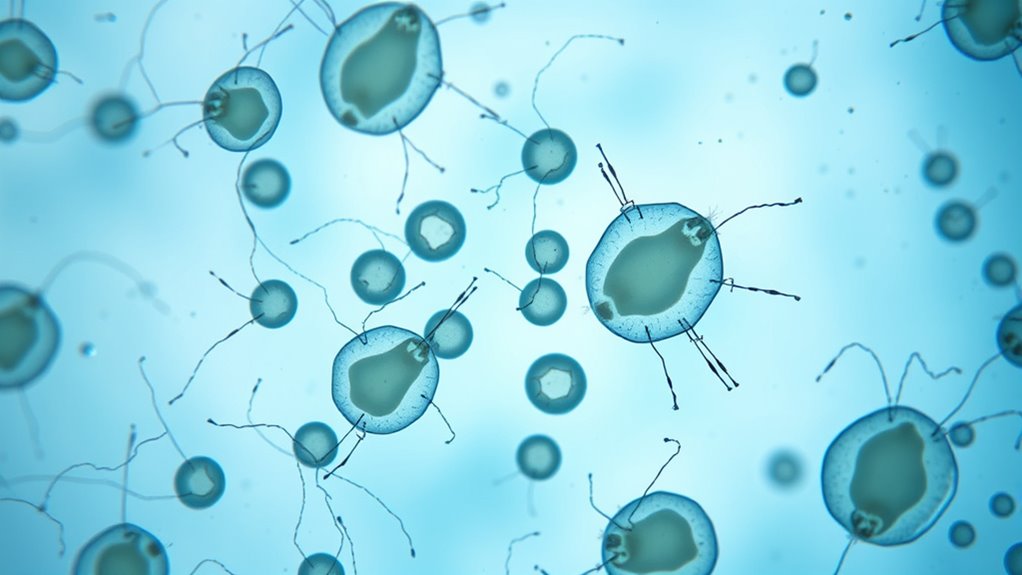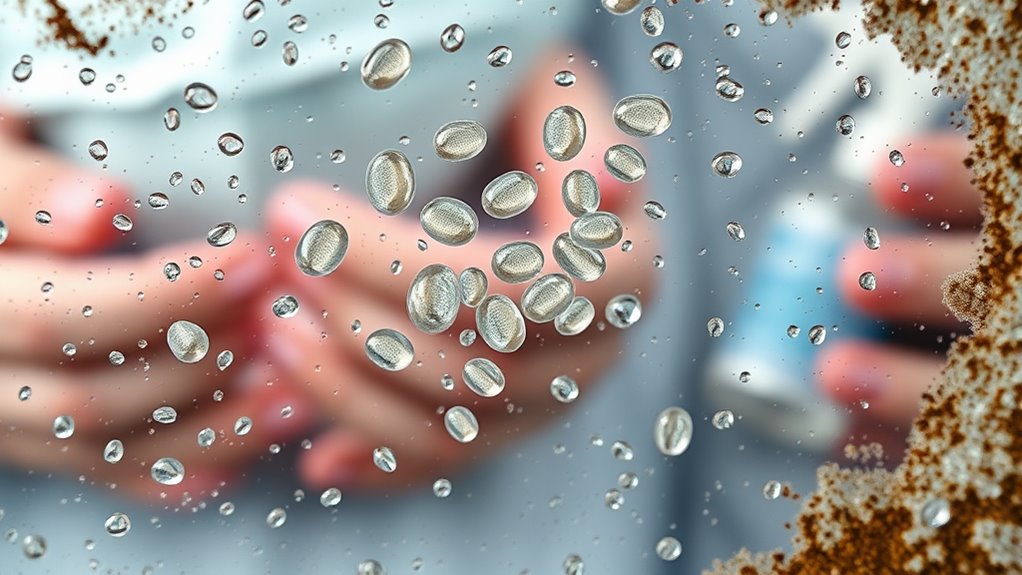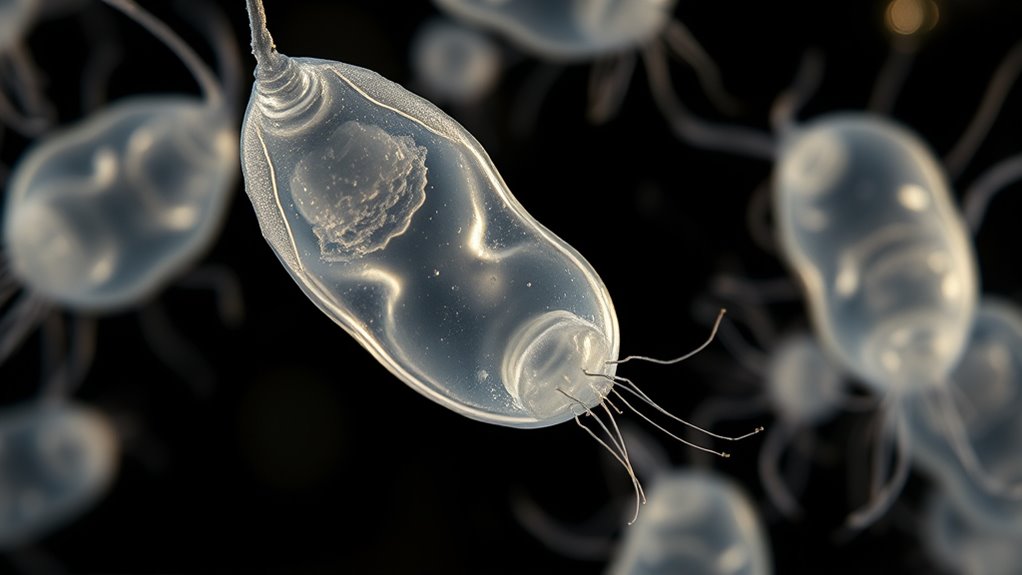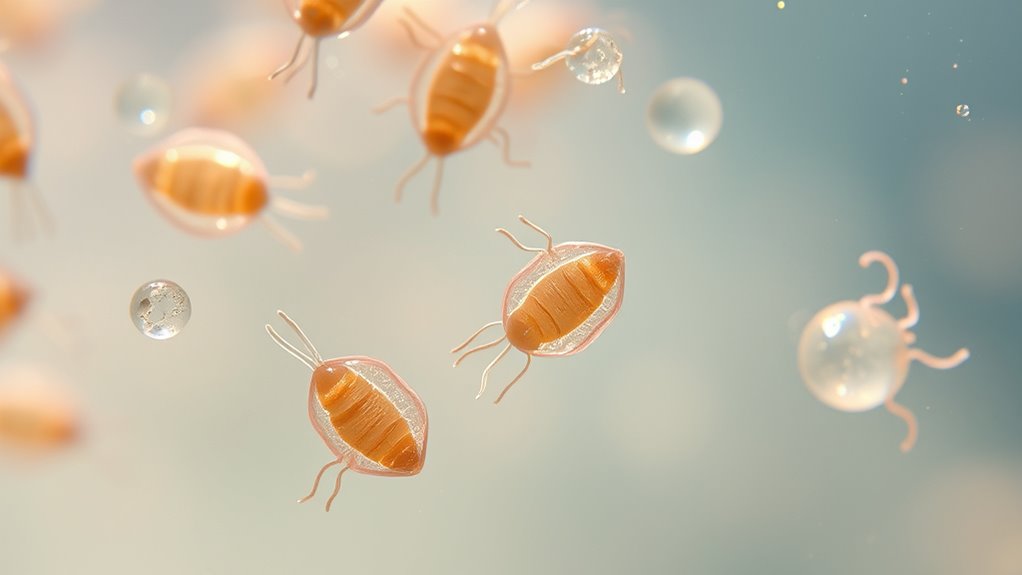Giardia and other protozoan parasites are single-celled organisms that cause gastrointestinal infections, often spread through contaminated water, food, or surfaces. You might experience symptoms like diarrhea, cramps, and fatigue. Diagnosing these infections involves microscopic exams, molecular techniques, or serological tests. Preventing infection hinges on good hygiene, clean water, and proper sanitation. If you stay aware, you’ll discover more about how these parasites impact health and ways to protect yourself.
Key Takeaways
- Giardia is a flagellated protozoan causing intestinal infections through cyst and trophozoite stages.
- Transmission primarily occurs via contaminated water, food, or contact with infected animals.
- Symptoms include diarrhea, cramps, bloating, and nausea, with diagnosis via microscopy, antigen detection, or PCR.
- Treatment options include drugs like metronidazole, but resistance is emerging, prompting vaccine and new therapy research.
- Other protozoan parasites, such as Entamoeba and Cryptosporidium, also cause gastrointestinal diseases with similar transmission routes and diagnostic methods.
Understanding Protozoan Parasites: An Overview

Protozoan parasites are single-celled organisms that can cause a wide range of diseases in humans and animals. Understanding their ecology helps you see how they survive and thrive in different environments, from water sources to host organisms. Their parasite lifecycle often involves multiple stages, including cysts and trophozoites, which enable them to persist outside and inside hosts. You’ll find that these stages are key to transmission and infection. By studying protozoan ecology, you gain insight into how they adapt and spread. Recognizing the different phases of their lifecycle allows you to grasp how they infect hosts and evade immune responses. This knowledge is essential for controlling and preventing diseases caused by protozoan parasites. Additionally, understanding the environmental resilience of these organisms can inform effective sanitation and control measures. The parasite lifecycle stages are crucial for developing targeted interventions that can break the transmission cycle and reduce disease prevalence. Furthermore, understanding their adaptation mechanisms can help in designing effective treatments and vaccines.
The Biology of Giardia and Its Relatives

Giardia and its relatives are flagellated protozoans that have adapted to survive in both aquatic environments and the intestines of hosts. Their diversity is remarkable, with different species exhibiting unique features. You can imagine their structure like this:
| Structure | Function | Location |
|---|---|---|
| Flagella | Movement and attachment | Surrounding the organism |
| Adhesive disc | Attaching to intestinal walls | On the ventral side |
| Nucleus | Genetic control | Inside the cell |
Their parasite life cycle is simple yet effective: they exist as trophozoites in the host’s intestines, dividing and causing illness, then form hardy cysts that exit with feces, ready to infect new hosts. This adaptability highlights their role in protozoan diversity and disease transmission. Understanding their life cycle is crucial for developing effective prevention and treatment strategies, especially considering their ability to form resistant cysts that can survive harsh environmental conditions.
How Protozoan Parasites Are Transmitted

Many protozoan parasites spread through contaminated water, food, or surfaces, making transmission a common route for infection. Waterborne transmission is especially significant; you might unknowingly drink contaminated water from lakes, rivers, or poorly treated sources. Imagine swimming in a pond where parasite cysts lurk unnoticed. Zoonotic spread also plays a role, as you could contract parasites from infected animals, such as pets or livestock, through contact or contaminated environments. To visualize this, picture:
- Drinking water tainted with parasite cysts during a hike.
- Handling infected animals or their feces without proper hygiene.
- Consuming improperly washed fruits or vegetables contaminated with contaminated water or soil.
- The increasing use of automation technologies in water treatment facilities aims to reduce contamination risks and improve safety. Additionally, poor maintenance of water systems can lead to system failures, increasing the likelihood of contamination. Recognizing contamination sources helps in implementing effective prevention measures and understanding the importance of proper appliance maintenance plans to prevent system failures.
Recognizing Symptoms of Protozoan Infections

Understanding how protozoan parasites enter the body is only the first step; recognizing the symptoms they cause is essential for early detection and treatment. Symptom recognition helps you identify infection signs quickly, so you can seek medical care promptly. Common symptoms include diarrhea, stomach cramps, bloating, and nausea. You might also experience fatigue, weight loss, or dehydration, especially with severe infections. Keep in mind that symptoms can vary depending on the parasite and infection severity. Some infections cause mild discomfort, while others lead to more serious health issues. Monitoring these signs allows you to take action early, reducing complications. If you notice persistent gastrointestinal issues or unusual fatigue, consult your healthcare provider to confirm whether protozoan parasites are involved. Early detection is crucial for effective treatment and recovery. Recognizing symptom patterns can aid in differentiating protozoan infections from other gastrointestinal conditions. Additionally, understanding transmission routes can help prevent future infections and promote better hygiene practices.
Diagnostic Methods for Detecting Protozoan Parasites

To identify protozoan parasites accurately, you’ll need to understand the key diagnostic methods available. Techniques like microscopy, molecular tools, and serological tests each offer unique advantages for detection. Knowing when and how to utilize these methods helps ensure reliable and timely diagnoses.
Microscopy Techniques Application
Microscopy remains a cornerstone in the diagnostic detection of protozoan parasites, offering direct visualization of the organisms in clinical samples. To enhance detection, you focus on:
- Applying staining techniques like iodine or trichrome to highlight structures.
- Preserving samples properly to maintain organism integrity.
- Using fresh or well-preserved specimens to prevent distortion or degradation.
Staining techniques improve contrast, making protozoa easier to identify under the microscope. Proper sample preservation prevents parasites from deteriorating or being missed, especially in stool or tissue samples. You might prepare smears or concentrates, then stain them for quick assessment. These methods allow you to detect characteristic features such as cysts, trophozoites, or flagella. Adapting these techniques ensures accurate, efficient microscopy-based diagnosis, critical for timely treatment decisions.
Molecular Diagnostic Tools
Molecular diagnostic tools have revolutionized the detection of protozoan parasites by offering highly sensitive and specific methods that complement traditional microscopy. Techniques like gene sequencing enable you to identify species based on genetic material, increasing accuracy. Molecular biomarkers serve as unique indicators for specific protozoa, facilitating rapid diagnosis. These methods allow for early detection, even when parasite loads are low, improving treatment outcomes. Here’s a comparison of key molecular tools:
| Technique | Application |
|---|---|
| Gene sequencing | Precise species identification through DNA analysis |
| PCR-based assays | Amplify target DNA for quick detection of protozoa |
| Molecular biomarkers | Detect specific parasite proteins or nucleic acids |
| Real-time PCR | Quantify parasite load and assess infection severity |
Additionally, advances in molecular diagnostics continue to enhance our ability to monitor and control protozoan infections more effectively. These tools streamline diagnosis, helping you respond swiftly to protozoan infections.
Serological Testing Methods
Have you ever wondered how clinicians identify protozoan infections when traditional methods fall short? Serological testing methods come into play, focusing on antibody detection and antigen identification. These tests offer a quick glimpse into the immune response or the presence of parasite components. Imagine:
- Drawing blood and isolating serum to detect specific antibodies produced against protozoans.
- Using enzyme-linked immunosorbent assays (ELISAs) to identify parasite antigens directly in blood samples.
- Employing rapid tests that give instant visual results for either antibodies or antigens.
These methods help confirm infections when microscopy or stool exams are inconclusive. They are especially useful for identifying past exposure or ongoing infections, providing essential diagnostic information for effective treatment.
Treatment Options and Medical Interventions

Effective treatment options for protozoan parasites depend on accurate diagnosis and the specific organism involved. Antiparasitic drugs, such as metronidazole and tinidazole, are commonly used to eliminate infections like giardiasis. However, resistance mechanisms can reduce their effectiveness, making it essential to monitor treatment responses. The table below highlights some common drugs, their targets, and potential resistance issues:
| Drug | Target Organism | Resistance Mechanisms |
|---|---|---|
| Metronidazole | Giardia, Entamoeba | Reduced drug activation |
| Tinidazole | Giardia, Entamoeba | Enzyme modification |
| Nitazoxanide | Giardia, Cryptosporidium | Reduced drug uptake |
| Paromomycin | Various protozoa | Drug efflux pumps |
| Furazolidone | Giardiasis | Enzymatic inactivation |
Understanding resistance mechanisms is crucial for developing effective treatment strategies. Research into new drugs and combination therapies can help overcome resistance issues. Monitoring treatment efficacy involves assessing patient response and potential drug resistance during therapy. Additionally, diagnostic accuracy is vital to selecting the appropriate medication and ensuring successful eradication of the parasites. Choosing the right intervention requires understanding these factors to optimize treatment success.
Preventing Infection: Tips and Strategies

To reduce your risk of protozoan infections, practicing good hygiene and adopting safe food and water habits are essential. First, wash your hands thoroughly with soap and water, especially after using the bathroom or handling raw food. Second, use effective water purification methods like boiling, filtering, or chemical disinfectants to eliminate parasites from drinking water. Third, avoid consuming untreated or questionable water sources and ensure produce is washed with safe water. Keep in mind: handwashing practices reduce transmission, while water purification prevents ingestion of contaminated water. Staying vigilant with these simple steps considerably lowers your chances of infection, protecting your health and the health of those around you.
The Impact of Protozoan Parasites on Global Health

Protozoan parasites pose a substantial threat to global health, especially in regions with limited access to clean water and sanitation. Their ability to adapt through parasite evolution impacts disease transmission and control efforts. By studying the protozoan genome, scientists uncover how these parasites develop resistance and new survival strategies. The diversity in genomes allows protozoa to infect a wide range of hosts, increasing their global burden. As these parasites evolve, they become more resilient against treatments, complicating eradication. The ongoing evolution emphasizes the need for continued research and improved sanitation practices worldwide. Additionally, understanding vetted treatments and their efficacy is crucial in managing infections caused by these adaptable parasites. Overall, protozoan parasites profoundly impact public health, causing illness and death in vulnerable populations, and their ability to adapt underscores the importance of global efforts to combat these persistent threats.
Special Considerations for Travelers and Immunocompromised Individuals

Travelers and immunocompromised individuals face heightened risks from protozoan parasites because their immune systems are less equipped to fight infections. To safeguard your travel health and support your immune response, consider these steps:
- Be cautious about drinking untreated water or eating raw foods that may harbor parasites.
- Use insect repellent and bed nets to avoid vector-borne transmission.
- Practice good hygiene, like handwashing with soap, especially before eating.
- Awareness of preventive measures can significantly reduce your risk of infection.
- Staying informed about protozoan parasite transmission can help you better understand how infections occur and how to avoid them.
- Recognizing the importance of food safety protocols can further minimize exposure to contaminated foods and water.
- Ensuring proper food handling practices, such as thorough washing and cooking, further reduces the risk of parasitic infections.
These measures help reduce exposure and strengthen your body’s ability to combat infections. Your immune response may not be as effective, so taking proactive precautions is crucial. Staying informed and vigilant can prevent illness and ensure a safer, healthier travel experience.
Emerging Trends and Research in Protozoan Disease Control

Advances in diagnostic techniques now allow for faster and more accurate detection of protozoan infections, helping you identify outbreaks early. Researchers are exploring innovative treatment strategies that could improve patient outcomes and reduce drug resistance. Additionally, environmental control measures are being developed to minimize protozoan transmission in endemic areas, enhancing overall disease management efforts. The integration of AI in healthcare is also starting to play a role in improving diagnostic accuracy and treatment planning for protozoan diseases. Incorporating tuning techniques from automotive contexts could inspire novel approaches to targeted therapy development.
Novel Diagnostic Techniques
Emerging diagnostic techniques are revolutionizing how you detect protozoan infections, offering faster, more accurate, and less invasive options. You can now rely on methods like molecular markers, which identify specific genetic signatures unique to each parasite. Genetic sequencing further enhances detection by revealing detailed genetic information, enabling precise identification of strains. Imagine:
- Using portable devices that analyze DNA on-site within minutes.
- Applying multiplex PCR to test multiple pathogens simultaneously.
- Employing advanced gene chips that scan for numerous molecular markers at once.
These innovations reduce diagnostic time, improve sensitivity, and help track outbreaks more effectively. As a result, you gain a powerful toolkit to identify protozoan parasites quickly, leading to faster treatment decisions and better disease control.
Innovative Treatment Strategies
Recent research is uncovering novel treatment strategies that promise to transform how you combat protozoan diseases. Scientists are exploring ways to induce genetic resistance in host populations, making infections less likely or severe. This approach could reduce dependency on traditional drugs and slow resistance development. Additionally, vaccine development is progressing rapidly, with promising candidates targeting Giardia and other protozoans. These vaccines aim to boost immunity and provide long-term protection, potentially reducing disease transmission markedly. Researchers are also investigating targeted therapies that disrupt parasite-specific pathways, minimizing side effects and increasing efficacy. Together, these innovative strategies represent a shift toward more sustainable, effective control measures. By integrating genetic resistance and vaccines, we’re moving closer to more durable solutions for protozoan disease management.
Environmental Control Measures
How can environmental control measures effectively reduce the spread of protozoan diseases? By improving water filtration and sanitation infrastructure, you can break transmission cycles. Visualize this process:
- Installing advanced filters in water sources to trap cysts and prevent contamination.
- Upgrading sanitation systems to safely manage waste and eliminate environmental reservoirs.
- Promoting community hygiene practices that reduce exposure to contaminated water and surfaces.
These measures target critical points where protozoa like Giardia thrive, preventing their spread. Innovations in water filtration remove infectious agents, while robust sanitation infrastructure minimizes environmental contamination. Together, these strategies form a frontline defense, protecting public health and reducing disease incidence. Implementing these control measures requires ongoing research and community engagement but offers a powerful way to curb protozoan infections.
Frequently Asked Questions
Can Protozoan Parasites Infect Animals Other Than Humans?
You might wonder if protozoan parasites only infect humans. The answer is no; they can infect animals too. Animal reservoirs play a key role, harboring the parasites and enabling cross-species transmission. This means that infected animals can pass parasites to humans and vice versa, often through contaminated water or food. Understanding these dynamics helps prevent infections and control outbreaks across different species, including your pets and wildlife.
Are There Any Vaccines Available for Giardia or Related Parasites?
Imagine you’re in the age of discovery, and vaccine development is still in its infancy. Currently, there are no vaccines available for Giardia or related parasites. You should focus on preventive measures like good hygiene and water treatment to protect yourself. Researchers continue working on vaccines, but for now, staying vigilant with hygiene remains your best defense against these protozoan infections.
How Long Can Protozoan Cysts Survive Outside a Host?
You ask how long protozoan cysts survive outside a host. Cyst survival depends on environmental resilience; they can persist for days to weeks in moist, cool conditions. Their durability allows them to withstand harsh environments, making water and soil sources risky. Proper sanitation and water treatment are essential to prevent transmission, as these cysts can remain infectious outside a host for extended periods, increasing the chance of infection.
Do Protozoan Infections Cause Long-Term Health Issues?
Imagine your body as a well-oiled machine suddenly hit by tiny troublemakers; that’s what protozoan infections can do. You might brush off initial symptoms, but some parasites cause chronic health effects and long-term complications. Left untreated, they can lead to ongoing fatigue, digestive issues, or immune problems. So, don’t ignore those symptoms—what seems minor now might turn into a long-term health saga you’d rather avoid.
What Environmental Factors Increase the Risk of Protozoan Outbreaks?
You should be aware that environmental factors like water contamination and poor sanitation practices critically increase the risk of protozoan outbreaks. When water sources become contaminated with fecal matter, protozoa can easily spread among communities. Inadequate sanitation facilities allow these parasites to thrive, making it essential to improve water quality and sanitation practices to prevent outbreaks and protect public health. Being mindful of these factors helps reduce your risk of infection.
Conclusion
By now, you see how vital it is to stay vigilant against protozoan parasites like Giardia. They can slip past your defenses if you’re not careful, so practice good hygiene, drink clean water, and seek medical advice if symptoms strike. Don’t let these tiny invaders catch you off guard—staying informed and prepared is your best shot at keeping them at bay. Remember, an ounce of prevention is worth a pound of cure.










